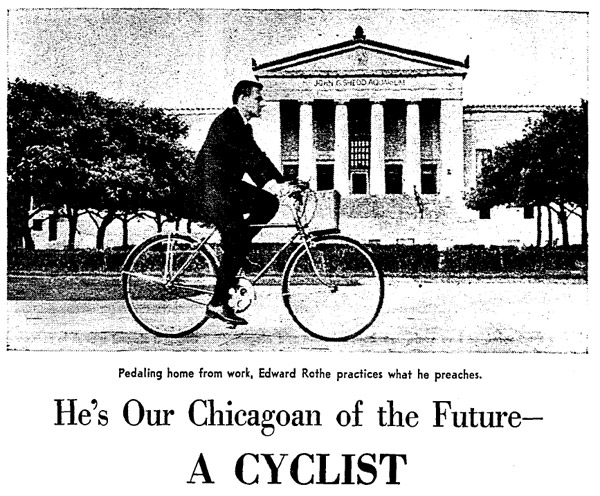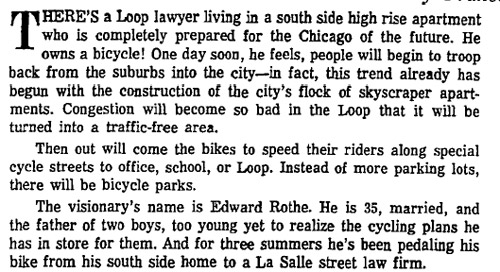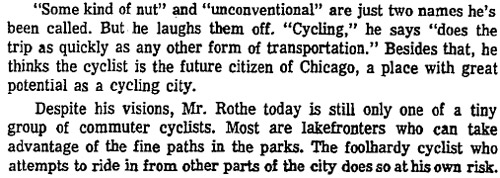
Chicago Tribune, July 7, 1963
In 1963, the Tribune was stunned to discover a bike commuter in Chicago. And not just any bike commuter—a Loop lawyer, presumably rich enough to drive, who traveled all the way from Hyde Park before the advent of the lakefront path.

Needless to say, he was considered something of a freak, even less than the "one percent" or the "hardly mainstream" labels bike commuters are given today.

Over the next few years, the Trib devoted a couple articles to bike commuters, who enjoyed the flexibility and fun of it but lamented the lack of infrastructure—there weren't bike racks all over the place in the 1960s. By 1970, things had completely changed, as Terri Schultz wrote at the time:
Last spring Paul Rasmussen of the Department of Development and Planning found buried in his drawer an eight-year-old feasibility study to develop bicycle trails along city streets.
The study was eight years ahead of its time. In 1962 urban bike enthusiasts were part of the social fringe you talked about at parties but didn't take seriously.
Today, the study has been molded into guidelines for a 200-mile one million dollar bicycle route system in the city.
[snip]
The proposal is a tribute to the cooperation between public officians and private ecology and biking groups.
The estimated "bicycle population" at the time was 1.2 million despite only 18 miles of bike paths; ABC even live-broadcast a transportation race from Madison to Halsted-Lincoln-Fullerton at rush hour, about 3.6 miles by bike. The bike won, at 19 minutes, followed by the El at 28, a car in 31 minutes, and the bus in 54 minutes. Something had clearly changed. The oil crisis of the early 1970s is usually credited with kicking off the bike revolution, but in 1970 gas prices, adjusted for inflation, were at historic lows, and close to the lowest they've been since. So I was a bit surprised to see that just before the crisis, Chicago already had an active bike movement, including the 300-member Association of Bicycle Commuters.
Just as important was the nascent environmental movement, an increased public understanding of air pollution, and increasing government regulation of air pollution. A few weeks ago, my wife and I went on a long bike ride coinciding with 10-year highs in mold count. She's always had problems with allergies and respiratory issues, and the airborne mold made her lungs hurt; I can't imagine what it would have been like biking in the early 1960s, when air quality was almost inconceivably worse:
In 1959 the city created the Department of Air Pollution Control. The new department investigated all types of emissions and suggested regulations for several previously ignored sources of pollution, including burning refuse and leaves. Public concern for air quality heightened after a 1962 disaster killed hundreds of London residents, and by 1964 Chicago received more than six thousand citizen air pollution complaints per year. As with the early movement to control smoke, the new activism focused on the potential negative health effects of impure air. Not surprisingly, the Loop, the Calumet Region, and northern Lake County, Indiana, were the most polluted districts in the metropolitan area.
In 1967 the U.S. Public Health Service determined that only New York City's air was more polluted than Chicago's. Impelled by citizen activism and new federal regulations in the 1970s, the city attempted to control the largest polluters, including the massive South Works steel plant. Even as these efforts began to reap benefits, however, the continuing suburbanization and auto dependence of the metropolitan area meant that auto emissions would plague the city for decades to come.
Notably, Schultz refers to "bicycle ecology groups" in the piece, suggesting that the movement was as environmental as it was economic. The next year, the Association of Bicycle Commuters rallied 600 riders for a "Bicycle Commuters Day" to raise awareness, and pushed for bicycle parking meters—no, really—at commuter rail line stops. In 1972, the city rolled out rush-hour bicycle lanes from Oak Street to Wacker Drive, with cop crackdowns on people who parked in them ("McDonough reported 29 parking violators found along Clark and 17 on Dearborn during the bike lane hours"). A year later, after the OPEC crisis kicked in, Pat Colander captured the public perception:
The redawn of the bicycle age is particularly fascinating to city people like myself, who often feel as tho they were born in commuter stations and weaned on carbon monoxide. There had always been a few weirdo types who preferred bike riding to more conventional means of getting around. But warnings of an energy crisis and fuel station shutdowns have caused even those of us brought up in the purtan ethic tradition of American capitalism to doubt the future of our Chevy Nova funds.
Perhaps that's why older writers are so angry at cyclists—it reminds them of a depressing period in American life (well captured by historians like Jefferson Cowie and Rick Perlstein), when the still-quite-new American empire seemed to be tumbling down, as best exemplified by the gas shortages of the 1970s. The gas-burning, chrome-covered sleds of yore gave way to a form of transportation previously left to "weirdo types" and the "social fringe." (Even worse, the Pinto.) It seemed like a civilization collapsing. I'm always mystified by people who freak out over bicycles, but it might just be generational. If you were lucky enough to miss the 1970s, it's just a way to get around; if you lived through that low dishonest decade, it's a symbol of privation.



